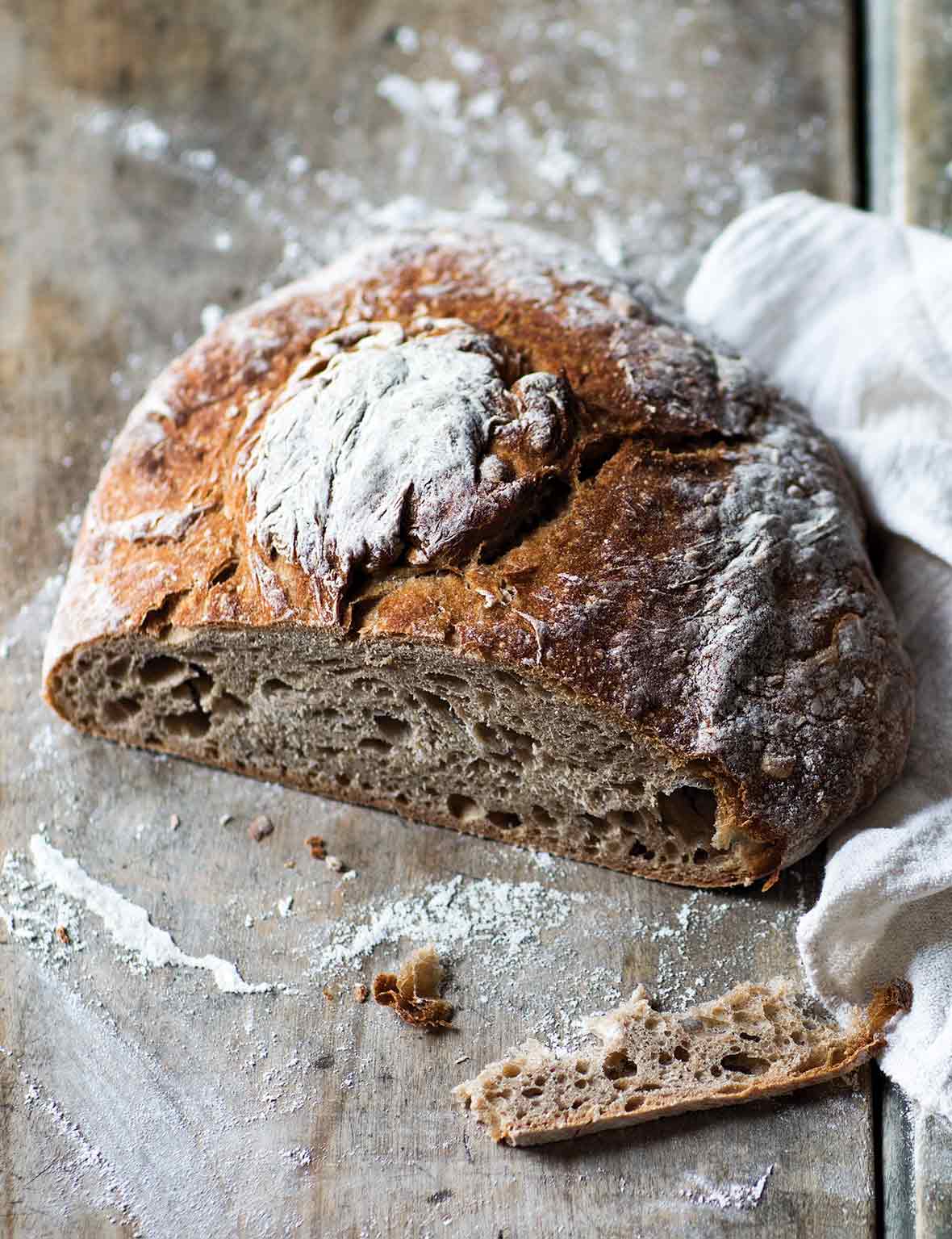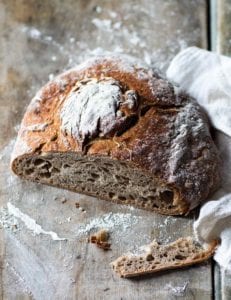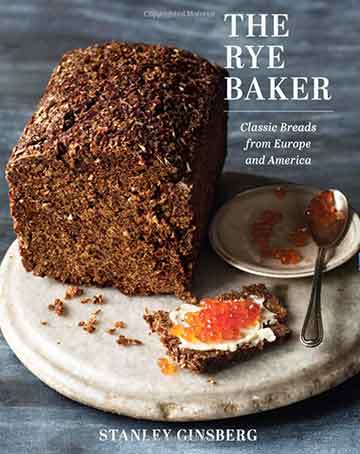
☞ Learn More, Read: How to Dry Sourdough Starter

Sourdough Rye Bread
Ingredients
For the rye bread sponge
- 6 ounces medium rye flour
- 6 ounces water
- 0.6 ounces rye sourdough starter
For the rye bread dough
- 10 ounces water, at room temperature
- 10.6 ounces bread flour
- 1 recipe rye bread sponge (see above)
- 2.3 ounces medium rye flour
- 1 1/2 teaspoons salt
- 1/3 teaspoon instant yeast
- Flour, for the work surface
Instructions
Make the rye bread sponge
- In the bowl of a stand mixer, mix the sponge ingredients by hand until incorporated. Cover and let ferment at room temperature (68 to 72°F or 20 to 22°C) overnight or for 10 to 12 hours. The sponge will be very bubbly, have a clean sour smell, and will have doubled in volume.
Make the rye bread dough
- Add the water and 1.8 ounces (50 grams) bread flour to the sponge and mix by hand until it forms a slurry, 1 to 1 1/2 minutes. Add 8.8 ounces (250 grams) bread flour and the rye flour and use the paddle to mix at low speed until the dough is evenly hydrated, 2 to 4 minutes. Cover the dough and let it rest at room temperature for 15 to 20 minutes.
- Add the salt and yeast to the bowl with the dough and mix with the dough hook of your stand mixer on low speed until the gluten is very well developed, 30 to 35 minutes. The dough should be sticky and very stretchy. Cover and let ferment at room temperature until doubled in volume, 2 to 2 1/2 hours.
- Preheat the oven to 430°F (220°C) with an oven rack adjusted to the middle position and a second rack in the lower position with a steam pan on it. [Editor’s Note: A steam pan is simply a pan filled with some water. You’ll want to use a pan with relatively high sides and only fill it partway with water as you’ll need to remove the pan from the oven when the water is very hot and you don’t want it sloshing all over you or your oven.] If using a baking stone, place it on the middle rack.
- Turn the dough onto a generously floured work surface and gently form it into a ball by folding it toward you, rotating 90 degrees, and repeating until the bottom surface is smooth. Flip the dough. If a traditional Galician rye bread shape is desired, pinch a golf ball-size piece of dough from the center of the loaf and carefully stretch it upward without separating it from the loaf, then form a depression in the dough and nestle the ball of dough inside the depression. Place the dough on a parchment-lined baking sheet or, if using a baking stone, on a well-floured peel. Cover and proof at room temperature for 10 minutes.
Bake the rye bread
- Bake the rye bread for 15 minutes.
- Remove the steam pan from the oven, quickly shut the oven door, and lower the temperature to 390°F (200°C). Continue to bake the bread until the crust is golden brown, the loaf thumps when tapped with a finger, and the internal temperature is at least 198°F (92°C), 15 to 25 minutes more.
- Transfer the loaf to a wire rack and let it cool completely before slicing.

Nutrition
Nutrition information is automatically calculated, so should only be used as an approximation.
Recipe Testers’ Reviews
Loved, loved, loved this sourdough rye bread recipe! It was perfect! This is an excellent recipe for those who love their classic sourdough rye bread. It turned out absolutely beautiful with a nice golden brown crust and a complex sourdough flavor. I am very, very pleased with this loaf and will definitely be making it again!
My crust wasn’t like some of the other rye bread recipes that I’ve made—it was a little softer and didn’t break your teeth.
My sponge started to really grow at around 6 hours and doubled at about 10 hours. The description was very good—it was indeed bubbly with a clean sour smell. If you’ve never made a rye sourdough like this before, it might be a little bit tricky since the dough is so wet, but you’re doing it right. It should be just a little thicker than pancake batter. And be very careful to not punch it down at any point once you’ve kneaded it with the dough hook for 30 minutes as this will help create an airy bread with an open crumb.
My loaf was beautiful!
This sourdough rye bread is a higher hydration dough, which was supposed to give it a nice open crumb. I didn’t achieve that, but it still had a nice flavor. It was a very mild sourdough rye bread and could go with many different foods.
I would be curious to try this recipe with less mixer time and some folds incorporated into the bulk fermentation. It was a difficult dough to work with. It will take practice for anyone to get the hang of but it was a fun challenge.










Curious about the sponge. In many of the recipes, the author calls for water at a temp of 105 degrees F (“warm”) when making the sponge, but here there is no guidance. I used tap water and 10 hours later my sponge doesn’t appear active (no bubbling or strong smell). ? His other recipes all specify water added to the sponge must be “warm”. I’m not sure whether this is an error in the book?
Also, is there an optimal time to pull from my sponge? Should I wait a certain number of hours after I last fed it (like I would with a sourdough starter)?
I started my sponge a week ago, in the evening and fed it every evening for a week. It appears healthy and active, and smells great. I fed it, then a couple of hours later pulled some to start the I sponge for this recipe. This is my first attempt at a rye starter so I’m in New and unfamiliar territory.
Any guidance to offer on what’s gone wrong? Thanks for your help.
Shanna, you’re correct, “warm” in terms of bread baking typically does refer to 105°F, and Ginsberg does specify that temperature for several recipes in this book, however, for this recipe, he didn’t specify any temperature for the sponge and for the bread dough he specifically states that the water ought to be at room temperature. As for being in New and Unfamiliar Territory, I’m right there with you when it comes to baking rye bread, so I’ve posed your question to a couple experienced rye bread bakers and asked them to respond to your sponge query. Thanks for your patience, we’ll be back with a response soon!
Curious if you ever got a response on this. I’m trying this recipe again and this time I’m going to use warm water. I don’t link my sponge was well enough developed last time, as I ended up with a doughy middle.
Shanna, no, I didn’t, but let me reach out to the publisher and see if I can get some answers for you!
Hi Renee, never heard back from Mr. Ginsberg so just ‘went with the recipe’ (which is always against my nature and why I could never be a recipe tester!) This was delicious bread. So much more subtle than a deli rye!
Lyn, I’m sorry to hear that you never received a response but I am thrilled that you like this bread as much as we do! Thank you so much for your patience and your perseverence! And I really appreciate you taking the time to let us know how well the bread worked out for you.
I’ve just fed my rye starter so I can make this – sounds delicious. Once the loaf is formed, it only gets a 10 minute rest before baking? Seems short. Is that because this is such a wet dough?
Lyn, wonderful that you’re making this! And yes, I believe that’s the reason, but for more information, you can turn to the author, Stanley Ginsberg, and his website, where he goes into the whys behind some of his recipes.
Thanks, Renee. I just searched around at his blog and couldn’t find any additional information – even under the French/Spanish/Portuguese category. If I find the answer, I’ll post it here. Appreciate your quick response.
Lyn, I appreciate you keeping us in the loop! And may I suggest you drop him an email? Here’s the place on his site that allows you to enter your email and your query. http://theryebaker.com/contact/ Fingers crossed he’s as responsive as I hope because he truly is the rye bread expert.